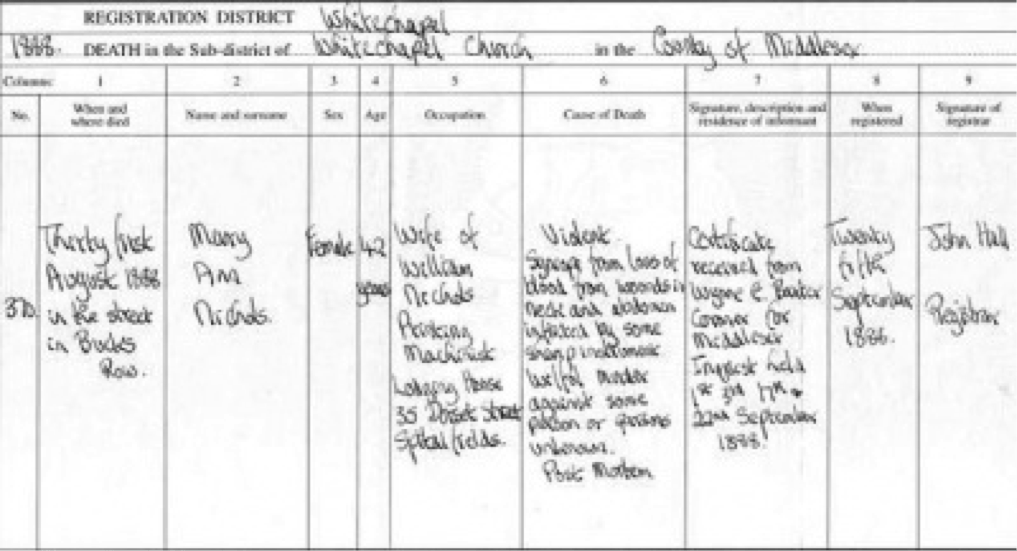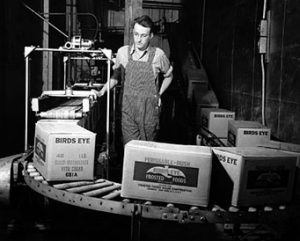Born on August 26, 1845 in London England, Mary Ann Walker was raised by locksmith Edward Walker and his wife Caroline. She married William Nichols, a printer’s machinist, in 1864; however, the couple divorced due to Mary’s drinking habits and prostitution allegations. Mary, now Mary Anne Nichols, continued practicing prostitution and was known for moving between workhouses and boarding houses, and living off charitable donations.

Prostitutes in Europe were regarded with mixed feelings in the nineteenth century. An awareness for the vulnerability of women prostitutes was fairly low and they were treated with curiosity as well as disgust. They had few economic options for making their way in the world and the women themselves were generally born into poverty and had little education or work skills. London prostitutes, especially those who operated on the streets, regularly picked the pockets of the men they preyed on. They kept an eye out for drunkards, from whom they could steal without the risk of being caught. However, this wasn’t the case with Mary as she herself spent most of her waking hours under the influence. Prostitution was very much frowned upon in London, and the women engaging in the profession were seen as the lowest of the low. It wasn’t unusual for men to beat and kill a prostitute after a ‘session,’ so when Mary Ann was found dead with her skirt lifted above her stomach, it was nothing out of the ordinary.1
The night in question was August 30, 1888. A heavy rain was falling on London during one of the coldest and wettest summers on record. Mary Ann was last seen walking down Whitechapel Road, and more than likely she was there soliciting her trade. Prostitution was a very dangerous profession one hundred thirty years ago. With no proper policing and the women themselves looked upon as animals, people would do with them as they pleased. No wonder the infamous ‘Jack the Ripper’s’ victims were all prostitutes.2 They were easy targets, and he was able to get away with murder.
Nichols was often found in the lodging house on 18 Thrawl Street; however, on this specific night she was knocked back due to a lack of money.3 Mary wasn’t fazed by this though, and was on her way back to her ‘office,’ the streets. At 2:30 am she ran into Emily Holland, another worker, who described Mary to be drunk and staggered against a wall. She told Emily that she was off to find another ‘punter’ in an attempt to get her ‘doss’ money in order to rest her head that night.4 One can’t help but think that Mary was selected by Jack because of her drunkenness and through no fault of her own she was destined to a brutal ending because she was such an easy victim. Emily Holland was the last known person to interact with Mary, and only one hour later, at 3:40 am, the latter was found cold and lifeless on the side of Bucks Row, a mere ten minutes walk from where the interaction took place.5

Constable Thain and Sergeant Kerby both passed down Bucks Row at 3:15, but reported nothing out of the ordinary. One must wonder what Nichols was doing from 2:30 to 3:40. She was only ten minutes away from Bucks Row, yet was found dead there seventy minutes later. Another thought would be: what was Jack the Ripper doing during that time. 6
Nichols’ body was initially found by two workmen, who both decided to leave her lying, as they didn’t want to be late for work. However, they let a police officer know her whereabouts on their way. Major bruising was found on Mary’s body and five of her teeth were missing. Investigators put this down to the struggle. Nevertheless, there were several deep cuts along her abdomen, which shows that her attacker enjoyed closeness with his victim, whom he supposedly raped and then mutilated. One can only speculate on why these cuts were made as they were, in no pattern, and didn’t relate to anything. As the first kill, maybe Jack was experimenting with Mary, and she was some sort of sick puppet in which his fantasies could be played out.7

Mary was buried on Thursday, September 6 of that year in the City of London’s Cemetery.8 Two days later, another of Jack’s victims, Annie Chapman, was found in the back garden of a London flat.9 Her womb had been removed and her body left horrifically mutilated. Jack the Ripper had indeed struck a second time. He wasted no time in preparing his second victim, yet this time it was more brutal than the first. One may wonder if Jack had attempted to remove Mary’s womb, but was perhaps disturbed and fled the scene before he could complete the operation.10 Jack the Ripper’s third victim was Elizabeth Stride. She was found at 1:00 am in Dutfield’s Yard, London. The fact that her throat had been cut, but the rest of her body had not been touched, led to speculation that her killer had been interrupted. This links with Mary Ann’s case because it is believed that Jack was also interrupted while working on her. One may believe that Jack liked the excitement of being caught, as he seemed to carry out his kills in the middle of streets. The fourth victim was found in Mitre Square in the City of London at 1:45 am. Catherine Eddowes was savagely mutilated by The Ripper, as her face was torn off and her uterus was missing along with her kidney. Clearly, Jack had not been interrupted this time. On November 9, the body of Mary Kelly was found in her room in Miller’s Court at 10:45 am. She had been virtually skinned to the bone and many experts believed that she was Jack the Ripper’s final victim. This was a fitting finale for the sick monster, as he chose a private area in order to carry out his most disturbing kill of all.11
For well over one hundred years since the time of the murder of Mary Ann and the rest of Jack’s victims, the identity of the killer has been regularly questioned, with nearly one hundred suspects having been named in the process. While many theories exist, none of them have proven to be indisputably convincing. Many think the Ripper was a commoner, possibly a butcher or other tradesman, who lived locally and was employed during the week, explaining why the murders occurred on or near the weekend. A lot of experts also agree that the Ripper was a local to Whitechapel. One of the most compelling suspects was Thomas Hayne Cutbush, who was a violent youth diagnosed insane at the time of the murders in 1888, and was believed to be wandering the streets of London throughout the time of the killings. Subsequently, the murders then stopped after Cutbush was locked up. Disappointingly, this information, along with more evidence, did not prove that Cutbush and Jack the Ripper were the same man; but there was enough evidence to keep Cutbush on the suspect list.12
The finger of suspicion was first pointed at Cutbush in 1894, by The Sun newspaper.13 The article claimed that despite the popular theory of the Ripper being dead, he was in fact a mental patient. The Sun’s detailed description clearly resembled that of Cutbush. The suspicion was that the Metropolitan Police covered up his guilt to avoid the embarrassing outcry that would have followed if the country’s most feared serial killer was found to be Superintendent Henry Cutbush’s nephew. Henry was a high ranked officer, whose reputation could have been seriously damaged if his relative was found to be Jack the Ripper. This is another reason why Thomas Cutbush was actively considered as a suspect.
Some named Cutbush as the No 1 Ripper suspect, but others have strongly denied this theory. Its main weakness is that the last known Ripper victim died in November 1888, at the end of the eleven week killing spree. If Cutbush was the killer, it seems odd that he would commit five murders over such short a period of time, stop for more than two years, and then commit one more assault, in which his victim survived. But there is almost no chance that the case will ever be solved. Thomas Hayne Cutbush remains top of the suspect list.14
It’s an eerie thought that this case will never be solved and even if it is, there is no one to suffer the consequences. It’s even scarier to think that there may currently still be serial killers on the run now that will also never be found and charged for their crimes. There will never be any justice for Jack the Rippers victims, but they can be certain they will never be forgotten.
- Mary Spongberg, The Body of the Female Prostitute in the Nineteenth-Century (New York, NY: New York University Press, 1997), 83-85. ↵
- Encyclopaedia Britannica, July 1998, s.v, “Jack the Ripper, English Murderer,” by John Phillip Jenkins. ↵
- Knocked back means dismissed. ↵
- A punter is a client. Doss is rent. ↵
- Stephen P. Ryder, “Casebook Jack the Ripper,” Victims: Last Addresses, August 14, 2009, 2, www.casebook.org/victims/polly.html. ↵
- Stephen P. Ryder, “Casebook Jack the Ripper.” Victims: Last Addresses, August 14, 2009, 2, www.casebook.org/victims/polly.html. ↵
- Salem Press Encyclopedia, January 2016, s.v. “Jack the Ripper,” by Cait Caffrey. ↵
- Death Certificate: no.370. 25 September, 1888. http://www.casebook.org/victims/polly.html ↵
- A back garden is a backyard. ↵
- William D. Rubenstien, “The Hunt For Jack the Ripper,” Ripper Diaries, (May 2000): 1-3. ↵
- Richard Jones, “Jack The Ripper 1888,” Victims (13 March 2016): 3. ↵
- Andy McSmith, “Madman’s notes throw new light on Ripper case,” The Independent article London, (19 November 2008). ↵
- A tabloid newspaper published in the United Kingdom and Ireland. ↵
- Richard Wheatsone, “Ripping Discovery,” The Sun (16 September 2017). ↵



211 comments
Edith De Loera
This article certainly gave me the chills. It was not only extremely exhilarating, but also insightful! I had never hear of Jack the Ripper or his victims. It is extremely unfortunate that even with our advanced technology, there are still many unsolved murders. What I found most intriguing is how all these murders occurred in a short time period of just eleven weeks. Also, every murder committed would significantly be worse and more excruciating. I can only imagine how terrified the town was during all these horrific events.
Megan Barnett
Outstanding article! The cover picture I think really caught my attention though, as on the grave it said “Victim of Jack The Ripper”. I found this strange and disrespectful to Mary, but it shows how known Jack was and in a since was used as a threat or warning to women prostitutes. His cruel way of killing and the fact that it was done mostly in public makes me wonder why his identity was never discovered. Is it possibly that one man could be so good at committing murders that he could do it whenever and not be caught?
Cristian Medina-Lopez
I thought this article was very interesting as to who Jack the Ripper’s first victim was. I agree with the author about how even if this crime were to be solved one day, it would have no affect on anyone. But although he is not talked about much today, it is still a very interesting topic to talk about that I enjoyed reading.
Maria Callejas
This was a total learning experience for me! I had no prior knowledge about who Jack the Ripper was, so thanks for providing this well-written insight! First of all great introduction, it caught my attention the minute I read it. Yet again, this is a horrific case that investigators have found no answers. It is truly amazing how he would go on to murder even more people. Overall, great article!
Alexis Renteria
In my forensics class I was so used to only learning about the serial killers background, what he did to his victims, and why he did such things. However, the way this article is structured, tells the story of the way some of his first victims lived which is something new for me. I am glad that you chose a serial killer as part of your article topic because it brings attention to the type of people that can be around you without noticing and the cruelty that happens around the world,
Troy Leonard
i have heard of Jack the Ripper and knew that he was a killer but i didn’t know what group of people he was killing. when i read he removed the womb of the woman he murdered i was very shocked. its almost like he was trying to take all the prostitutes off the streets by killing them. but the way he was doing it was very disturbing and he had to have been 51/50.
Jesica Rivera
It’s easy to come across the topic of Jack The Ripper, but I don’t think most people come across the story of his victims. To see how he started off and evolved as a killer shows just how twisted he became the more time he spent with his victims. It’s easy to see how easily he got away from justice when the first murder was disregarded due to her profession.
Erik Shannon
This is a great article. I was not previously aware of who Jack the Ripper was until I read this article. I find it crazy that this is still an unsolved murder. I also find it crazy how he killed off so many women in his murders and each one became worse. This article was well written and it kept me wanting to read more.
Oceane Roux
Thank you for this well-written article! I have definitely heard of Jack the Ripper before, but I had never heard of the story of his first victim. Jack the Ripper has been subject to many myths, and it’s crazy to imagine the reason of its act. I am honestly still wondering what his motive was and I think no one will ever know for sure.
Anthony Robledo
Great article! The introduction was spot on. Its interesting how you approached this article as well. Most people usually write about how we dont know who jack the ripper really is or about who they speculate he or she is. I knew nothing about what jacm the ripper actually did untill now. Could you imagine if this still occurs now with prostitutes. I know recently a few bodies were found in the deserts of arizon and this article makes me think about how we could habe a 2nd jacm the ripper happening now. Keep up the good work!